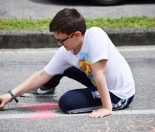An overview article on What is Dyspraxia, including signs and symptoms and what treatment is available. Dyspraxia is broadly defined as a neurological disorder of motor co-ordination that involves difficulty in thinking and purposeful movement.
What is Dyspraxia?
To understand what dyspraxia is we must first learn what “praxia” is.
Praxia is from the Greek word “praxis” which means movement process.
Praxis is the process by which we figure out how to plan our actions and move our bodies easily towards achieving a goal.
Praxis enables the young child (after much trial and error) to learn how to carry out gross and fine motor movements such as crawling, walking, running, hopping, jumping and skipping. Also, it enables the child to learn how to do many more complex tasks, such as how to dress herself, tie her own shoe laces, manage a knife and fork at the table without making a huge mess, and swim overarm.
As the child enters school, praxis is the process used to learn a myriad of new tasks, such as how to write, remember how to do long division, plan and write a story or essay, catch a ball and throw it back to a partner, shoot goals in netball and learn new skills in gymnastics.
Movements developed via praxis are not reflexive or automatic movements such as the primitive reflexes of sucking and grasping. They are movements which are purposeful, chosen and require planning.
How does the process of Praxis work?
1. First must come the idea or goal.
An infant’s goal might be to ‘get up that step’, ‘to get that spoon into my mouth’ ‘to put those blocks in that box’ or ‘to get out of my cot and find Mum’.
The goal arises as a result of many hours of sensory experience in the environment, taking in sounds, sights, textures, smells, taste, and experimenting with moving the body, in the process developing body awareness and spatial awareness orientation.
A wide range of related sensory information will need to be available which has been processed and stored in the sensory memory bank via previous experience, before the task can even be attempted.
2. Then the plan of action must be formulated.
This is sorted out by the motor planning part of the brain in the parietal lobe. It must decide before anything else happens which positions the various parts of the body will need to be in during this task, which muscles will be needed, which are to contract and which are to stretch, how the fingers and hands must move in order to achieve the goal and also the sequence of all these movements.
For example, if the goal is to climb up one step, the brain must sort out which muscles will be needed for each small segment of the plan, which might look something like this:
1. Move one hand up onto the step
2. Move the other hand up onto the step
3. Move the knees up onto the step one at a time
4. Turn around
5. Finally sit down to admire the view.
3. Execution of the plan
The other senses of balance, self movement and proprioception are also involved and all senses need to be functioning in an age appropriate fashion so that the child can successfully carry out the plan.
This is where it all comes together: the initial sensory experience, the forming of the goal, the motor plan and the execution of that plan. If all goes well the infant learns a new skill, enjoys a new sensory experience and with some repetition and persistence can add this to his growing repertoire of skills.
4. Storage of the plan for future use.
The plan is then stored in the cerebellum for future use. With each subsequent similar or identical task the cortex (where the idea is formed) alerts the cerebellum as to which plan is the most appropriate. Modifications are made by the cerebellum to suit the new situation and the plan is carried out.
Frequent repetition of movements leads to increased dendrite development in the brain so that in the future, once these message pathways are laid down, action plans can be relocated more quickly when needed. Plans are then actioned and the movements then occur quickly and smoothly, without the need for conscious planning and trial and error.
AND ALL OF THIS HAPPENS IN A FLASH!
Developmental dyspraxia therefore is the condition in which this motor planning system in the brain and body does not function well from birth.
It is a neurologically based disorder. This means that at some point in the process of planning, carrying out that plan and storing that plan for future use, the neurological pathways needed for these tasks are not connecting properly.
The breakdown may be in the following:
- sensory system (poor collection and storage of sensory information),
- incomplete dendrite development ( the nerve pathways which branch out from neurons in the brain ),
- a lack of neuro transmitters ( substances which enable the messages to leap across the gaps between dendrites), or
- in the storage and retrieval department in the cerebellum.
What does Dyspraxia look like?
Dyspraxia is like dyslexia in that there are no immediately visible means by which dyspraxic children can be quickly identified.
Dyspraxic children look completely normal, and are often very bright, articulate, and just as delightful, curious and loveable as any other child.
However the following signs will become visible once the dyspraxic child is placed in a situation where a learned skill is taken out of context, or a new skill presents itself to be quickly mastered. An experienced teacher with a practised eye will notice these signs and symptoms, but often not understand that they are caused by a developmental disorder.
The effects of dyspraxia range from very mild (only a few of the signs below) to more severe (where many of these signs are evident). The most severe cases are usually picked up in early childhood by paediatricians because of delays in milestones. Milder cases are picked up by parents or early childhood teachers, and the very mild may not be noticed until later on in primary school where sequencing tasks become more complex and demanding.
The following list of signs is intended at a general guide. However there may be other underlying reasons for these difficulties. If you suspect that your child may have dyspraxia, a thorough assessment by an appropriate professional is suggested.
Common Signs & Symptoms
Common signs of Developmental Dyspraxia in children are as follows:
- Clumsy and accident prone from a very young age
- Frequently bangs into things or people
- Slow to learn to crawl and walk
- Uncoordinated, awkward gross motor movement
- Messy eater, difficulty learning to feed himself, and later managing a knife and fork
- Slow to learn to dress himself and later have difficulty tying shoe laces and doing up buttons
- Slow to hold crayons or a pencil correctly, cut with scissors and draw (may avoid these activities.)
- Slow to learn how to skip ( will often gallop instead)
- Difficulty coordinating movements of arms and legs when learning how to swim
- Inconsistent ability to do motor tasks. For example he may be able to learn a new task one day but has forgotten it by the next.
- Difficulty learning how to hold a pencil, form letters, print and write words
- Difficulty recalling the sequence of letters in words when spelling
- Difficulty remembering the sequence of mathematical processes (especially subtraction and division)
- Difficulty with word retrieval — he knows what he means but cannot find the right word
- Difficulty reading aloud (jerky , skips words, eyes may wander to the line above or below indicating a difficulty in planning eye movements)
- Has good ideas but cannot get them onto paper. Ordering and sequencing of sentences and paragraphs takes too much energy, so may lose concentration.
- Reluctance to try new games or activities involving movement such as folk dancing, sports and gymnastics
- Difficulty planning social interactions and maintaining friendships without getting overwrought. May be able to make friends quickly but have difficulty retaining them.
- Tantrums and meltdowns may occur more often than usual for age from sensory overload and frustration
Treatment – What can I do if I think my child may be Dyspraxic?
First get an assessment. Children under the age of 7 can be assessed by a paediatric occupational therapist at your local Early Childhood Developmental Service. These centres are free, funded by the Ministry for Education.
The OT will then most likely give you a set of exercise, activities and games designed to support the areas lacking in function. These may be sensory activities to stimulate the sensory processing aspect of the disorder, activities involving the use of motor skills which need more repetition than usual to become established.
Children over the age of six can be referred by their teacher to the GSE service for assessment and support in the classroom.
A trained and experienced neuro developmental therapist will also be able to give you an excellent assessment and there are now a number of private practitioners in this field working in New Zealand.
A programme of therapeutic developmental movement exercises may be given to assist your child, some of which will need to be done at home and others in the clinic. However the most severe cases should be assessed by a paediatrician to rule out other medical issues and conditions.
You should also visit the Dyspraxia Support Group of New Zealand website.
For more information on learning impairments in children, see our Learning difficulties section.
Ref: Judy Davis, ( 1997) “Planning to Move, Moving to Plan”, published by the Dyspraxia Support Group of NZ ( Inc).







Hi,
I’m raising my late sisters Son and I had heard it was free to get under 7’s tested, his schools learning support team brought up the possibility of this condition..
He turns seven in two months so I’m trying to organise this ASAP.
The only issue is that everywhere sounds surprised at the notion of it being free to get tested.
I’m in Christchurch, does anyone have any advice about where to find my local Early Childhood Developmental Service?
Any advice appreciated. thanks.
Hi Tony, you should get in touch with the good people at Dyspaxia NZ: http://dyspraxia.org.nz/ Apparently they’re having their national conference in ChCh next month. So they should know what’s around your neck of the woods. Best of luck — Jarrod.
Hi my son will be 5 in April and would like to know if you know the best places to get assessed for dyspraxia in taupo please?
Hi there, Is there a centre in South Auckland?
Hi there, my nephew has dyspraxia and is being bullied by his teacher. He is in year 8 and is struggling badly. Could you please recommend the best place for us to get support. Thanks so much
Hi Kate, Where in NZ are you?
is there a clinic in Napier I can take my son to?
Hi Debbie,
Rosemary has suggested: Bettie Huibers, Reg. Extra Lesson Practitioner, Waipukurau, huibers@xtra.co.nz ph 06 8586009
Good luck!
Rochelle
Any clinic in wellington?
Hi there,
I just sent Rosemary an email and they do some clinics in Wellington so if you get in touch with her office- http://www.developlearning.co.nz/ they can let you know.
Kind regards,
Rochelle